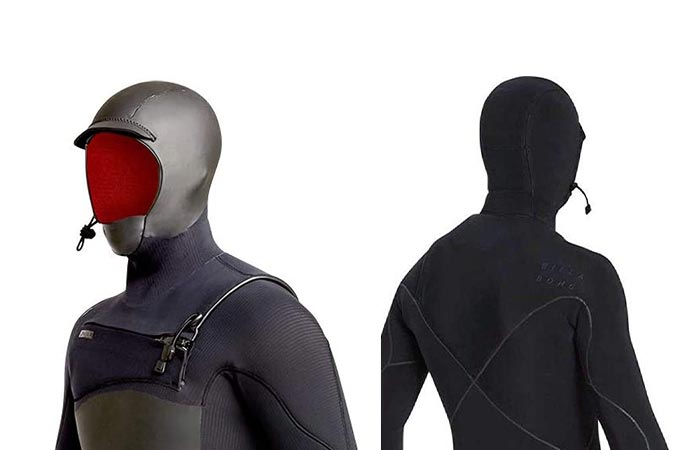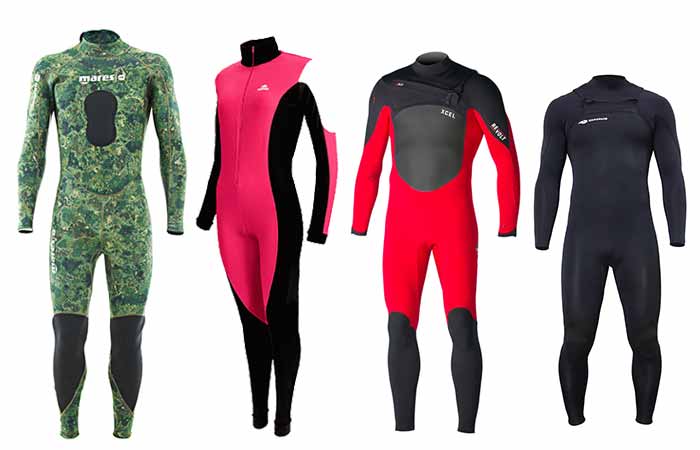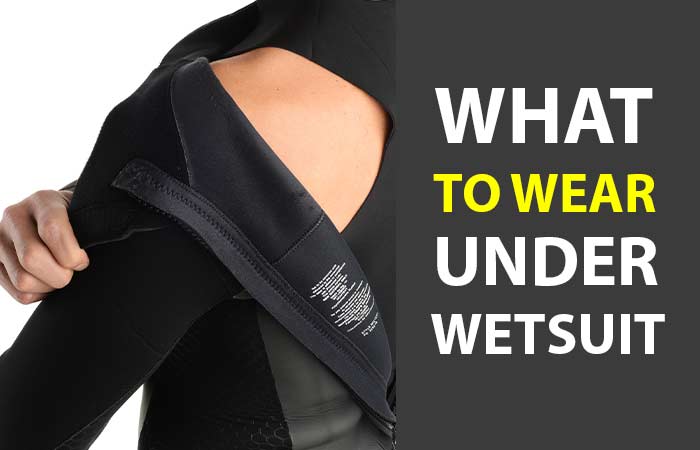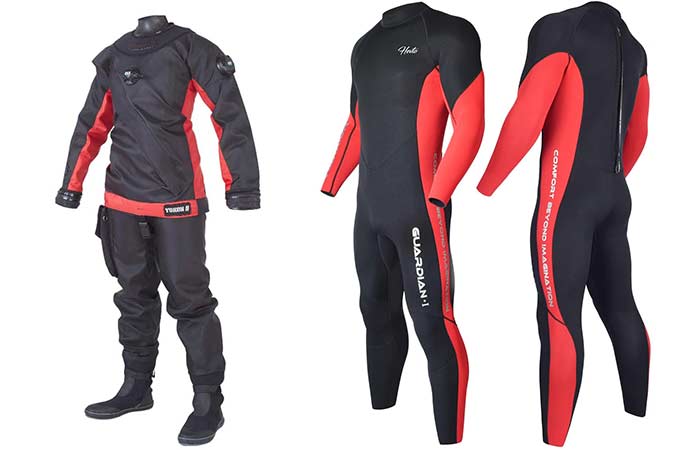What are Wetsuits Made of? Types & Top Brands
If you are a water sports fan, one of the most common things you’ll have noticed is the garment worn by anyone going into the water. Wet suits, as they’re called, are protective water wear that come in different colors, sizes and styles.
Following are details on what exactly they are, what they’re made of, their purpose, types and the top brands
What is a Wetsuit?
A wetsuit is a unique type of stretchable garment worn by individuals who engage in water sports and other activities inside or out of water.
They are called wetsuits because they help maintain the warmth of your body by not necessarily keeping water out, but by using thermal regulation and the body’s own heat to warm up the water that gets inside.
They are commonly worn by stand-up paddle boarders, canoeists swimmers, divers, sailors, or surfers both in cold and warm waters.
What are Wetsuits made of?
Wet suits are made out of a flexible synthetic rubber material of varying thickness known as neoprene. Use of neoprene makes wetsuits stretch to provide a good fit for the body. The neoprene is hydrophobic meaning that it makes the wetsuits water proof. Quality neoprene is also lightweight and durable .
Most sources credit Dr. Hugh Bradner, an American physicist and a diving enthusiast, as the inventor(1950s) of the modern wet suit. Jack O’Neill, a surfer, is also said to have invented the wet suit still in the 1950s
Purpose of a Wetsuit-What do Wetsuits do?
The primary purpose of a wet suit is to keep your body warm in cold waters. This helps wearers avoid severe low body temperatures, a condition known as hypothermia.
In addition to thermal insulation, wet suits also do the following
- Protection from abrasion that may result from objects in water such as sharp rocks and reefs
- They make you more buoyant
- Protection from ultraviolet exposure when in and out of water
- Protection against jellyfish and other marine organism stings
Types of Wetsuits
The various types of wetsuits include the following:
1.Wetsuit Vest
As denoted by its name, this wetsuit is in the design of a vest, singlet or tank top but provides the needed protection. Its main purpose is to protect the body from wind chill while providing freedom especially in the summer.
Wetsuit vests are usually made of neoprene about 2 to 3 millimeters thick. Given that it only covers your arms and upper body, you’ll need something for the lower body to keep warm and for the obvious reason of covering your nakedness.
The advantage with having a wetsuit vest is that it shows off your muscles and tattoos and doesn’t impede your motions when paddling for example. On the other hand, if you’ve not shaved your underarm hair, it’ll do little to hide it. Also, if you have small arms that you’re not proud of showing off, avoid this vest.
2.Short John (Jane) Wetsuit
The Short John wetsuit cover from the thighs upwards but doesn’t cover the arms. It mainly covers the torso thus providing warmth in the core region. It’s best suited for surfing and other water activities at dawn. This way, your body won’t heat up too much when the sun rises.

The advantage with this type of wetsuit is that it can be worn with shorts for a better look. The fact that your arms are exposed also has the advantage of helping expose your tattoos and muscles for a better look. The downside is that it takes some time taking it off.
3.The Springsuit
The Springsuti is a type of wetsuit that comes with short legs (up to the knees) and either long or short arms. It’s a good fit for the summer surf when you don’t want too much covering but still want a warm core.
The good thing with this wetsuit is that it helps keep the sun off your torso while still just keeping you warm and not too hot. You can choose the long or shorter arms (up to the elbows) for the best option. You still have your legs out for the sun.
4.The Fullsuit
The Fullsuit is the one providing cover for the whole body. It covers the neck, body, arms and legs. It’s the best for longer dives and surfs or with colder waters. Also called the Long Arm Steamer, it can at times have a hood on it. Combined with gloves, booties and a heated rash guard, you can easily dive in it for quite a while.
Most Fullsuits will be about 2 or 3 mm thick. For colder waters, go for between 4mm and 6mm. The best thing about this suit is that it offers the best protection in the water and even on land such as from the sun. However, it’s not the best for paddling especially when it the thick type.
5.Wetsuit Jacket
The wetsuit jacket adopts the feel and look of a jacket but it’s worn directly unto the skin. It has full-length arms and covers from the neck to the waist line; just like a jacket. It even has a zipper running from the neck to the waist.
Its thickness is usually between 1 and 2 mm which isn’t very good when in cold waters. Also, given that it only covers the upper body, you’ll need something to cover up the lower part of your body. It provides good protection save for the zip which could be a bit uncomfortable for paddling.
6. Long John (Jane) Wetsuit
Remember the Short John Wetsuit? This is the longer and fuller version of it. It retains the short vest-like arms while providing protection for the torso all the way to the ankles. For this reason, it’s best suited for areas where the water is cold but the air is a bit warm.
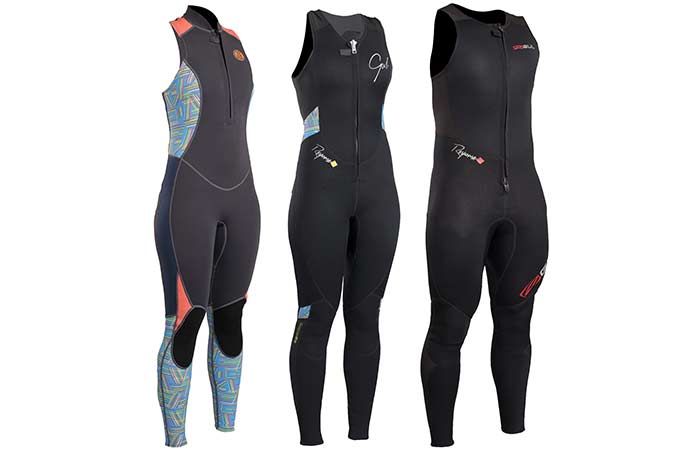
It has the advantage of also covering the knees preventing any chaffing but still leaves your arms exposed. Still, it’s a good design as it helps you cool off your body when you step out of the water. If you have great arms, you can easily show them off in this wetsuit.
7.The Short Arm Steamer
The Short Arm Steamer, unlike the Long Arm Steamer which is the Fullsuit, is a wetsuit covering most of the body except the forearms (elbow to wrist). It’s meant for colder waters and has a mix of different neoprene thicknesses with 2mm and 3mm on different parts of the body.
It works great for paddling as it doesn’t hinder your motions in any way. It can also be combined with other gear for shallow diving and in slightly warmer waters than a Fullsuit for example. In general, it’s one of the best for cold waters just next to the Fullsuit.
8. Shorty wetsuit
The shorty wetsuit has short sleeves and short legs.
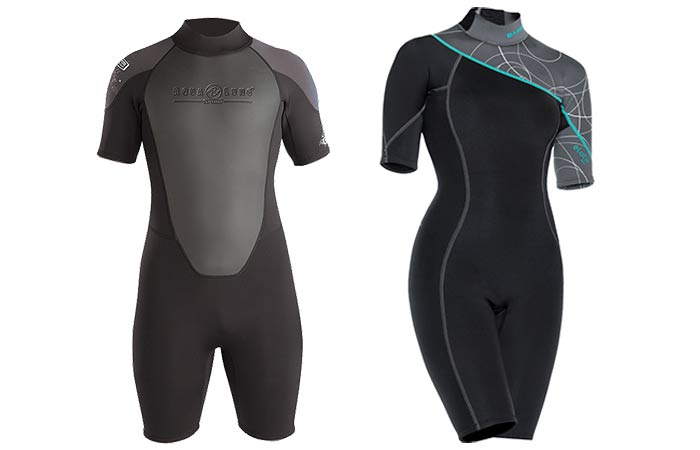
9.Bottoms
These are shorts or tights to be worn either alone or with an upper body garment. They cover from the waist downwards with the shorts going to the knees while the tights go all the way to the ankles for better body coverage.
The type of wetsuit you go for will depend on the temperature of the area you’ll be diving or swimming and the time of day. These aspects dictate the type and thickness of the wetsuit as well. For the actual thicknesses, the table below gives a guide:
| Water Temperature | Temperature in Degrees (C) | Wetsuit Thickness |
| Frigid | Below 7 | 5 – 7 mm |
| Cold | 8 – 11 | 3 – 5 mm |
| Cool | 12 – 17 | 2 – 3 mm |
| Warm | 18 – 25 | 1 – 2 mm |
| Tropical | 26 + | UV Lycra |
Wet Suit Brands and Manufacturers
The top and most popular brands of wetsuits include;
- O’Neill
- Rip Curl
- Peak
- Xcel
- Billabong
- Hurley
- Patagonia
- Matuse
- Isurus
More on Wetsuits
- How do Wetsuits Work?
- Wetsuits Colors: Why Black? What is the Best Color?
- Wetsuit vs Dry Suit
- How to Properly put on a Wetsuit, Remove+ Dos & Don’ts
- What to Wear Under Wetsuit: Female, Men & Triathlons Undergarments
- How Tight/Fitting should a Wetsuit be?
- Wetsuit Thickness Guide + Temperature Chart
- How to Wash a Wetsuit + Best Cleaners, Shampoo & Soap
- How to Dry a Wetsuit + Best Drying Hangers & Racks
- Wetsuit Storage and Care Tips
Best Wetsuits


